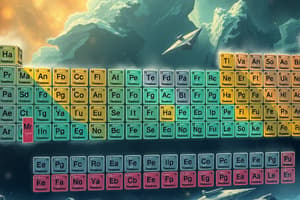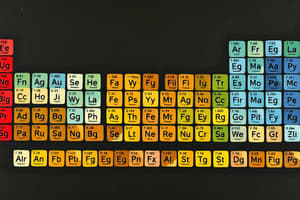Podcast
Questions and Answers
What is the primary reason atoms react in accordance with the octet rule?
What is the primary reason atoms react in accordance with the octet rule?
- To achieve high energy levels
- To obtain a full set of eight valence electrons (correct)
- To create more stable isotopes
- To maintain a balanced charge
Which of the following best describes a polyatomic ion?
Which of the following best describes a polyatomic ion?
- A neutral atom with an even number of protons and electrons
- An ion consisting of two or more atoms with a charge (correct)
- An ion formed from the loss of a single electron
- An ion that can only act as a cation
How do Lewis symbols visually represent valence electrons?
How do Lewis symbols visually represent valence electrons?
- With colored circles around the element's symbol
- By placing dots around the element's symbol (correct)
- Using horizontal lines between each pair of electrons
- Through shading the element's symbol
What type of ion is formed when an atom loses electrons?
What type of ion is formed when an atom loses electrons?
What does the octet rule indicate about nitrogen's valence electrons?
What does the octet rule indicate about nitrogen's valence electrons?
What is electronegativity?
What is electronegativity?
What is the trend for metallic property as you move top to bottom in the periodic table?
What is the trend for metallic property as you move top to bottom in the periodic table?
What trend does ionization energy follow as you move from top to bottom in a group of the periodic table?
What trend does ionization energy follow as you move from top to bottom in a group of the periodic table?
Which of the following is NOT a property characteristic of metals?
Which of the following is NOT a property characteristic of metals?
Which of the following is a monomer of carbohydrates?
Which of the following is a monomer of carbohydrates?
What is the primary energy source among biomolecules?
What is the primary energy source among biomolecules?
What defines non-metals in terms of their ability to form ions?
What defines non-metals in terms of their ability to form ions?
What happens to electron affinity as you move from left to right across a period?
What happens to electron affinity as you move from left to right across a period?
As you move from left to right across a period, how does metallic property change?
As you move from left to right across a period, how does metallic property change?
Which of the following statements about disaccharides is correct?
Which of the following statements about disaccharides is correct?
What is the electronegativity range for metalloids?
What is the electronegativity range for metalloids?
What is the trend in electronegativity as you move from top to bottom in the periodic table?
What is the trend in electronegativity as you move from top to bottom in the periodic table?
What is the effect of atomic size as one moves down a group in the periodic table?
What is the effect of atomic size as one moves down a group in the periodic table?
What is a common property of non-metals that distinguishes them from metals?
What is a common property of non-metals that distinguishes them from metals?
What best describes a polymer?
What best describes a polymer?
Which of the following correctly states the trend for non-metallic property across a period?
Which of the following correctly states the trend for non-metallic property across a period?
What are the basic building blocks of lipids?
What are the basic building blocks of lipids?
Which of the following is NOT a polysaccharide?
Which of the following is NOT a polysaccharide?
What is the primary function of nucleic acids in living organisms?
What is the primary function of nucleic acids in living organisms?
Which elements are present in proteins?
Which elements are present in proteins?
What type of molecule is formed when glycerol binds with three fatty acids?
What type of molecule is formed when glycerol binds with three fatty acids?
Which statement is true regarding valence electrons?
Which statement is true regarding valence electrons?
What are amino acids classified as in the context of proteins?
What are amino acids classified as in the context of proteins?
Which of the following best describes the octet rule?
Which of the following best describes the octet rule?
Which scientist is known for organizing the elements by increasing atomic number using x-rays?
Which scientist is known for organizing the elements by increasing atomic number using x-rays?
What is the significance of Mendeleev's arrangement of elements?
What is the significance of Mendeleev's arrangement of elements?
What does the term 'periodicity' refer to in the context of the periodic table?
What does the term 'periodicity' refer to in the context of the periodic table?
What did John Newlands contribute to the periodic table?
What did John Newlands contribute to the periodic table?
In the modern periodic table, what distinguishes groups from periods?
In the modern periodic table, what distinguishes groups from periods?
What was one of John Dalton’s main contributions to the early concept of the periodic table?
What was one of John Dalton’s main contributions to the early concept of the periodic table?
Which of the following statements about non-metals in the periodic table is true?
Which of the following statements about non-metals in the periodic table is true?
What was the primary basis of Johann Dobereiner's classification of elements?
What was the primary basis of Johann Dobereiner's classification of elements?
Flashcards
Modern Periodic Table
Modern Periodic Table
A table that organizes elements by increasing atomic number, with elements in the same group sharing similar properties.
Periodic Table Groups
Periodic Table Groups
The vertical columns of the periodic table, containing elements with similar chemical properties.
Periodic Table Periods
Periodic Table Periods
The horizontal rows of the periodic table, displaying elements with increasing atomic number.
Mendeleev's Periodic Law
Mendeleev's Periodic Law
Signup and view all the flashcards
Moseley's Contribution
Moseley's Contribution
Signup and view all the flashcards
Periodic Table
Periodic Table
Signup and view all the flashcards
John Dalton
John Dalton
Signup and view all the flashcards
IUPAC
IUPAC
Signup and view all the flashcards
Electronegativity Trend
Electronegativity Trend
Signup and view all the flashcards
Ionization Energy Trend
Ionization Energy Trend
Signup and view all the flashcards
Electron Affinity Trend
Electron Affinity Trend
Signup and view all the flashcards
What are biomolecules?
What are biomolecules?
Signup and view all the flashcards
Monomers
Monomers
Signup and view all the flashcards
Carbohydrates
Carbohydrates
Signup and view all the flashcards
Monosaccharide
Monosaccharide
Signup and view all the flashcards
Disaccharide
Disaccharide
Signup and view all the flashcards
Representative Elements
Representative Elements
Signup and view all the flashcards
Metallic Property
Metallic Property
Signup and view all the flashcards
Non-Metallic Property
Non-Metallic Property
Signup and view all the flashcards
Atomic Size
Atomic Size
Signup and view all the flashcards
Electronegativity Trend: Across a Period
Electronegativity Trend: Across a Period
Signup and view all the flashcards
Electronegativity Trend: Down a Group
Electronegativity Trend: Down a Group
Signup and view all the flashcards
Metallic Property Trend: Down a Group
Metallic Property Trend: Down a Group
Signup and view all the flashcards
Metallic Property Trend: Across a Period
Metallic Property Trend: Across a Period
Signup and view all the flashcards
Octet Rule
Octet Rule
Signup and view all the flashcards
Lewis Dot Structure
Lewis Dot Structure
Signup and view all the flashcards
Valence Electrons
Valence Electrons
Signup and view all the flashcards
What are ions?
What are ions?
Signup and view all the flashcards
Monoatomic & Polyatomic Ions
Monoatomic & Polyatomic Ions
Signup and view all the flashcards
What are valence electrons?
What are valence electrons?
Signup and view all the flashcards
What is the Octet Rule?
What is the Octet Rule?
Signup and view all the flashcards
What is a polysaccharide?
What is a polysaccharide?
Signup and view all the flashcards
What are the building blocks of lipids?
What are the building blocks of lipids?
Signup and view all the flashcards
What are proteins made of?
What are proteins made of?
Signup and view all the flashcards
What are nucleic acids?
What are nucleic acids?
Signup and view all the flashcards
What are the main elements in carbohydrates?
What are the main elements in carbohydrates?
Signup and view all the flashcards
What are the main elements in proteins?
What are the main elements in proteins?
Signup and view all the flashcards
Study Notes
Periodic Table
- A useful tool for organizing elements
- Arranged by increasing atomic number, left to right
- Columns are called groups, elements in the same groups share similar properties
- Rows are called periods
- IUPAC (International Union of Pure and Applied Chemistry) updates and monitors the table
- Metals are generally on the left and center; nonmetals are on the right
- Elements are arranged into vertical columns called groups or families and horizontal rows called periods or series
History of the Periodic Table
- 1808: John Dalton theorized that atoms of the same element are the same
- 1817: Johann Dobereiner proposed the Law of Triads, grouping elements into sets of three based on atomic weights
- 1864: John Newlands proposed the Law of Octaves, noticing repeating patterns every eighth element when ordered by increasing atomic mass
- 1869: Dimitri Mendeleev, considered the "Father of the Modern Periodic Table", arranged elements by increasing atomic mass and grouped them by similar chemical and physical properties
- 1913: Henry Moseley rearranged elements by increasing atomic number, improving the accuracy of the periodic table
Periodic Trends
- Systematic variations in element properties across the table
- Metallic properties: The ability of an atom to lose an electron. Increases from top to bottom, decreases left to right
- Non-metallic properties: The ability of an atom to gain electrons. Increases from left to right, decreases top to bottom
- Atomic size: Half the distance from the nucleus to the outermost shell. Decreases left to right, increases top to bottom
- Ionization energy: Energy required to remove the most loosely bound electron. Increases left to right, decreases top to bottom
- Electron affinity: Energy released when an atom gains an electron. Increases left to right, decreases top to bottom
- Electronegativity: Tendency of an atom to attract electrons when bonding. Increases left to right, decreases top to bottom
Biomolecules
- Important for the survival of living cells
- Include lipids, nucleic acids, carbohydrates, and proteins
- Monomers: Small, basic molecules that bond to form larger, more complex molecules called polymers
- Carbohydrates: Organic compounds made of carbon, hydrogen, and oxygen; primary energy source (sugars, starches, fibers)
- Lipids: Fatty compounds; essential for energy storage, structure, protection, signaling (glycerol, fatty acids)
- Proteins: Large, complex molecules made up of amino acids
- Nucleic acids: Store and transmit genetic information (nucleotides)
Chemical Bonding and Lewis Structures
- Chemical bonds: Forces holding atoms together in compounds
- Valence electrons: Electrons in the outermost shell of an atom, play an important role in bond formation
- Lewis Structures: Diagrams showing the arrangement of valence electrons in molecules
- Octet rule: Atoms tend to react in order to gain, lose, or share electrons to achieve a full outermost electron shell (8 valence electrons)
Types of Ions
- Monatomic ions: Single atoms with a positive or negative charge formed by losing or gaining electrons
- Polyatomic ions: Groups of two or more atoms that carry an overall charge due to the gain or loss of electrons
Studying That Suits You
Use AI to generate personalized quizzes and flashcards to suit your learning preferences.




